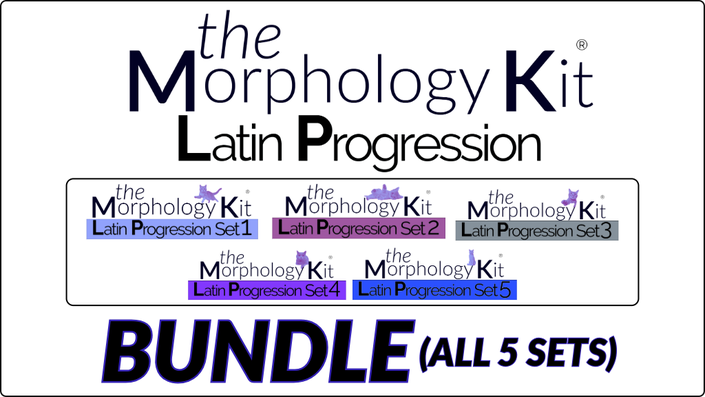Latin Progression FAQs
How does the Latin Progression support student learning?
The Latin Progression provides students with structured, explicit instruction and engaging activities to deepen their understanding of morphology.
Students gain the ability to recognize and apply morphemes in reading, writing, and spelling, building critical skills in vocabulary, syntax, and word analysis.
Teaching morphology is new to me. Will I be able to teach my students using the Latin Progression?
Yes!
Even if you’re new to morphology, you can effectively use the materials. A basic understanding of morphology (affixes and base elements) and etymology is all you need to begin.
As you work through the lessons, you’ll gain a deeper understanding of the structure of English alongside your students!
What are the prerequisites for students starting the Morphology Kit Latin Progression?
The Latin Progression is ideal for students in grade four and above who have completed a phonics sequence covering at least a third-grade level.
My students have already studied some of the morphemes in the Latin Progression. Is the material still appropriate for them?
Yes!
Even if your students are familiar with the senses of meaning of some morphemes, the activities provide valuable opportunities to deepen their word knowledge. They will apply their morphological awareness to reading, spelling, syntax, and vocabulary.
Is the Latin Progression appropriate for whole-class instruction?
Yes!
Instructor-led Core Lessons can be completed interactively as a group. Activities can then be done independently, in small groups, or as a class, with follow-up discussions to reinforce learning.
Is the Latin Progression appropriate for intervention?
Yes!
All students benefit from explicit instruction in morphology, but it is particularly effective for students with language-based learning differences.
How do the materials in the Latin Progression enhance students' morphological awareness?
The Latin Progression materials strengthen students' morphological awareness through explicit instruction and diverse practice activities.
Students not only learn the senses of meaning of common affixes and base elements, but also level-up their morphological awareness. They develop the ability to recognize these morphemes in spoken and written words, and understand their spelling patterns.
As well, they explore and practice how adding suffixes transforms base elements and words, uncovering the relationships between words and their derived forms.
Do I need to follow the Latin Progression sequence?
Following the sequence is recommended but not necessary. The Latin Progression begins with a review of suffix spelling conventions and introduces more transparent (less abstract) morphemes, gradually introducing more complex ones, such as base elements with alternating forms. The sequence also incorporates review slides. However, instructors may adjust the progression to suit their needs.
How long does a Latin Progression lesson take to complete?
It varies depending on the setting and students’ needs.
Each Morpheme Lesson in a Pack is composed of 2 sections, a Core Lesson and Activities.
A Core Lesson usually takes anywhere from 15 minutes to 30 minutes to complete. And, a Core Lesson plus all the Activities typically takes about 60 minutes.
Do my students need to complete every activity?
No. Some activities are more challenging than others. Choose those that best suit your students’ needs.
Do I need to complete the Core lesson and all the activities in one class/session?
For most Morpheme Lessons, we recommend completing the Core Lesson in one session.
Activities can be spread out and incorporated into later sessions as review or assigned for independent practice.
Can the activities be done independently?
Yes.
The Core Lesson is teacher-led, while most activities can be done independently or in small groups (apart from Word Chains, which require a partner).
If students complete the activities independently, we recommend reviewing the materials together to provide feedback and corrections. In intervention settings, interactive instruction of all the materials (including the activities) is highly effective.
How much support should I offer?
Provide scaffolding as needed. For example, you can read sentences or paragraphs aloud while the students fill in the blanks.
Completing some activities orally is also fine—not every response needs to be written or typed.
We have a helpful Tips & Suggestions document that you are welcome to download.


